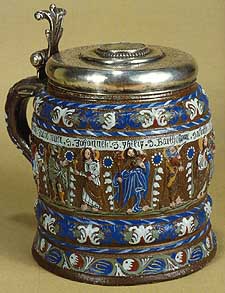
by James R. Stevenson
It appears that beer drinking has a bright future as Americans and Europeans continue to increase their consumption. For centuries people have been interested in drinking beer and in producing appropriate drinking vessels for it. The first [drinking vessel that we recognize as a] stein dates back hundreds of years to the sixteenth century, and most historians agree that the Germans deserve credit for inventing it.
 |
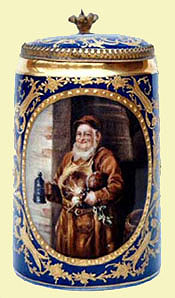 |
Once the beauty of steins became recognized, interest in making them spread. During the eighteenth century, steins were made throughout Europe. The most productive period in the history of stein making, and the period of greatest interest in them occurred in the second half of the nineteenth century when the “Mettlach” steins were produced.
Beauty and art appear in steins made from many kinds of materials — glass, salt glaze pottery, porcelain, silver, pewter, copper, ivory, stoneware, and faience. True collectors appreciate the art and recognize quality in steins regardless of the material of which they are made or the factories in which they were produced. A high-quality stein is collected for its intrinsic value as well as its investment potential.
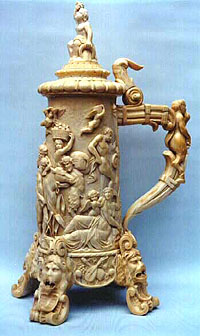 |
The fine quality and workmanship also appear in porcelain and ivory steins, with their stunning and detailed relief. Human figures and animals in many pewter relief steins are exceptional for their realism. Many hand-painted steins depicting military, occupational, and other scenes also exhibit high quality.
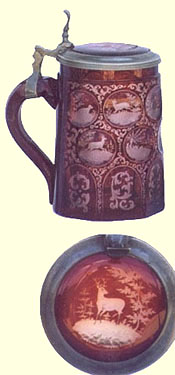 |
Royal Vienna, Meissen, and Capo-di-monte steins offer unusual examples of porcelain artistry and have become the specialty of many sophisticated collectors. The number of these steins available is limited, and most are in the hands of a few collectors and museums. Their prices are high and will continue to climb as collectors recognize their importance in the art world.
Many companies began producing steins in the nineteenth century, and most collector steins available in the market today were made in the later nineteenth and early twentieth centuries. Manufacturers often marked the steins under the base, usually by engraving. The steins usually collected in this category are Villeroy and Boch, HR, Merkelbach and Wick, Reinhold Merkelbach, Albert Jacob Thewalt, Simon Peter Gerz, J. W. Remy, Matthias Girmscheid, and Marzi and Remy.
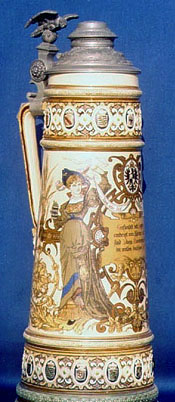 |
Many other stein factories stamped or engraved the words musterschutz or gesetzlich geschüzt under the base, which simply meant that the particular design of the stein was patented or protected by law. Other companies were not allowed to duplicate the stein. Musterschutz is found mainly on porcelain character steins manufactured by the Schierholz Company. Gesetzlich geschüzt is found on many types of steins. Numerous steins also have Germany engraved or stamped under the base, which indicates that they were produced after 1892 when German law mandated this imprint for exported pieces. It is interesting that many unmarked steins (production-line workers simply missed them) can be identified by other characteristics, such as the quality of the etching, interior linings, body designs, and lids. Many unmarked steins can, almost without doubt, be attributed to Villeroy and Boch, HR or some other particular company because of such identifying characteristics.
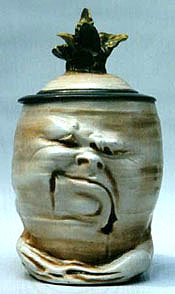 |
The quality of steins varied over the years, and the collector with a keen eye can often identify steins that were expensive when they were made. Steins were made for everyone and could be purchased for less than one mark or as much as thirty marks ($7.50) for the seven-liter 1161 Mettlach stein. Other high-priced Mettlach steins were the Saint Florian (DM 6,80) and the David and Goliath (DM 8,00). (In 1910 one U.S. dollar equaled four German marks.) The quality and size determined the price. The porcelain character steins were also expensive. The famous [Schierholz] “stag” porcelain stein blended as many as ten molds together, and this required fine craftsmanship. It surely demanded a high price, although I have not been able to find original prices for [Schierholz] character steins.
In purchasing Mettlachs, the stein collector can refer to the Villeroy and Boch 1885/Mettlach 1905 catalog, published by Hans J. Ammelounx, and use the original prices for guidelines. There are exceptions, but as a rule of thumb, expensive steins have held their value in today’s market.
Philosophies of Collecting
Collectors vary in their philosophies and reasons for collecting. There are as many philosophies as there are collectors. Jack Lowenstein, in an article in Prosit (September 1978), writes that people collect steins for three basic reasons: (1) nostalgia, (2) the compulsion to accumulate, and (3) the desire to amass negotiable wealth. I agree with these three explanations. I have met numerous collectors over the years and discussed their philosophies with them in person. Other have expressed their motives in letters and phone calls. The points of view differ widely, but the three reasons offered by Lowenstein are common to many collectors.
Collectors usually change their approaches and hence their types of purchases over a period of years. Mostly this is because they become more informed and sophisticated. Most of us start collecting steins by purchasing the cheaper ones. Then, as we read books, and see more steins, and discuss stein collecting with our colleagues, we realize that we are neophytes in a professional business.
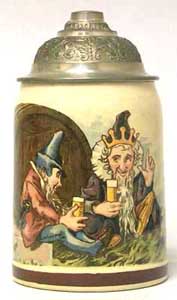 |
Many collectors purchase only Mettlach steins because they feel that this ensures that they are getting quality, a limited-edition item, and an investment that will appreciate. Some will not consider other steins for their collections. Some buy other steins but only with the intent to trade or sell them for Mettlachs.
Military-stein specialists are a unique group, but they have become numerous. In fact, the interest in military steins has been so great that John Harrell has recently published his second book on military steins. The military collector is more of a historian than other collectors. [Editors note: Regimental Steins, by John Harrell, was last reprinted in 1983. Other more current works have since been published.]
There is a group of collectors who concentrate on HR steins, which are attributed to Hauber and Reuther of Freising, Bavaria, by Mike Wald in his book HR Steins. Theresa Thomas, in her book Keramik, attributes HR steins to Herman Roch. Collectors value HR steins because they are limited in number, usually marked, and are of high quality, particularly in their etched designs. The HR collector is convinced that his steins approach Mettlach quality, and it is interesting to hear arguments on both sides. I will not show my prejudices, but will admit that I own both types and will let the open market determine the price and quality of each. In recent years, however, the price difference between HR and Mettlach steins has decreased substantially. In fact, in many cases the etched ones are only about $150 apart.
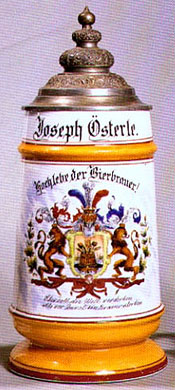 |
Particular subjects interest some collectors; there are sports, towers, Munich Child, miniatures, early glass, characters, Westerwald, Meissen, and etched steins. The list is infinite and collectors everywhere have different tastes and likes.
Some collectors are interested in obtaining particular series of steins, such as the Mettlach “book” steins of the 2001 series, which depict twelve professions, or the occupational series of Mettlach stein 2719 to 2730. This approach must surely be a challenge, and establishing a complete set must be gratifying. Only a few collectors have the complete set. One collector recently purchased a stein from me to add to a set that had begun with the master three-liter stein and he is now seeking the half-liter ones.
I attended a stein auction recently and noticed a gentleman reading a newspaper as if completely uninterested in the proceedings. The sale contained a variety of steins with prices varying from $19 to $2,600 for a beautiful ivory stein with mythological figures. Finally, a faience stein appeared. The gentleman bid diligently and succeeded in beating his competition. He immediately folded his paper, paid his bill, and left the auction. His interest in this particular type of stein is another example of specializing. There are also numerous collectors searching for early Westerwald and Kreussen steins.
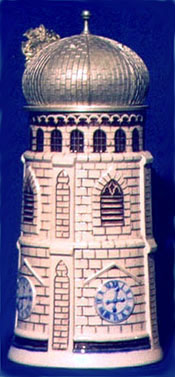 |
Lithophane steins are attractive to many stein hobbyists. Since the making of lithophanes is a specialty, most stein factories purchased them and did not produce them. I have found it a pleasure to show non-collectors the lithophanes on my steins, for these designs are often appreciated more than the steins themselves. I especially enjoy showing them my LAW (bicycle club) lithophane. It should be mentioned that specializing in a particular theme can lead to interest in creating a club. Clubs have been formed in the areas of lithophane, military, and Munich Child steins. The Münchner Kindl (Munich Child) is a symbol of Munich and Bavaria.
It can be difficult to complete a particular series or purchase a rare stein. I have been searching for years for a Royal Vienna. I left a phone bid last year on a Royal Vienna at an antique auction. I was successful in obtaining it at a price of $250. The stein presently has a value of $1,250.
Sports were popular in Germany and Europe in the nineteenth century, and certain collectors find this theme fascinating. Many bowling steins are available on the market today, and they range from etched scenes to characters.
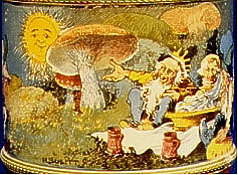 |
The comedy theme, particularly as handled by the German artist Heinrich Schlitt, is popular today among Mettlach collectors. Collectors find the PUG scenes on Mettlachs quite humorous with dwarfs bowling, drinking, playing, or just sitting in nests. Scenes of drinking, running, or fighting in battle are also interesting, and collectors have purchased such steins for this reason. One collector revealed to me that fifteen years ago he was collecting only steins with dwarf scenes when he decided to diversify because he was becoming too specialized. He purchased a one-liter ivory stein to add to his collection. This is the way collectors’ philosophies evolve.
Many collectors are interested in character steins, and since Dr. Eugene Manusov’s Encyclopedia of Character Steins was published, interest in these steins has grown even more. I find them fascinating and amusing and have frequently shown some of mine to collectors and non-collectors. The opinions vary from “Isn’t it cute?” to “What a nice face” and “Isn’t it ugly?” Those who collect character steins must take the insults along with the praise.
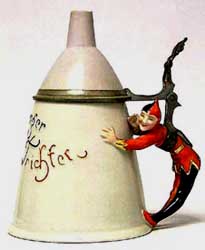 |
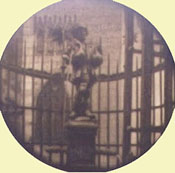 |
One cannot force another collector to love or enjoy a particular type of stein. Art grows on an individual, and the true collector appreciates the philosophies of others. We purchase steins for our own gratification and cannot expect others to have similar tastes.
I do not specialize in any particular type of stein, but I do have a philosophy. I would like to build a collection of the best examples of the various makers who produce steins. To coincide with this approach, I hope to add excellent examples of all types of steins to my collection. In the near future, I will search for an eighteenth-century Meissen, an ivory, an enameled Biedermeier glass, and the [Schierholz] boar. As I purchase, I also consider the salability of the piece, recognizing that, as my interests change, I may wish to sell the stein and purchase others.
__________
*This article includes two chapters from the book Antique Steins, A Collectors Guide, by James R. Stevenson (Second Edition, Revised, Cornwall Books, Cranbury, NJ, 1989), and is reprinted with the permission of Associated University Presses. Minor changes have been made to reflect the advance of knowledge which has occurred in the nine years since originally written, and these are marked with square brackets. Editing for The Beer Stein Library was done by Walt Vogdes, who has also provided the accompanying photographs.
New material ©1998 Beer Stein Library — All rights reserved.